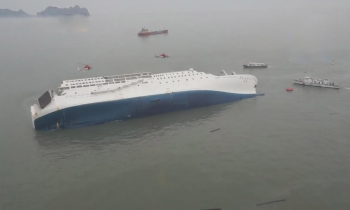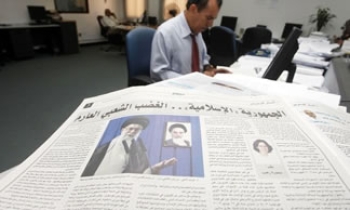The variety of perspectives offered by the online international news environment is limited. It offers little real information diversity, a situation sharply at odds with a decade and a half of fervour for the democratising potential of new media, a study by the University of Ulster's Centre for Media Research has concluded.
Online news websites have improved access to international news but since fewer news sources are used, the variety of perspectives offered is limited, according to research conducted by the centre's Chris Paterson. Much of what passes as "news" online is often from just two sources, Reuters and Associated Press, who provide most of the English language international news, television news pictures, and text for international stories on the internet, says Paterson.
Millions of people who access news headlines online using popular portals like MSN.com, AOL.com or Yahoo.com, are being duped by the online news industry, concurs the study 'News Agency Dominance in International News on the Internet'.
"Through an examination of the content of major web news providers, our study confirms what many web surfers will already know – that when looking for reporting of international affairs online, we see the same few stories over and over again. We are being offered an illusion of information diversity and an apparently endless range of perspectives which in fact what is actually being offered is very limited information."
Even though international news flow on the Internet has increased in apparent diversity of original reporting, in terms of actual diversity of original reporting it has decreased or remained static.
"This is done by offering readers a variety of additional links to local and regional newspapers around the world. However, since most of these outlets have used the same news agency copy as the online version, the story is basically the same and the links are irrelevant as they do not give another perspective. While the online news industry continues to pretend for the moment that it brings readers a diversity of reporting on world news, it is a pretence which cannot last."

Traditionally, journalists have relied on news agencies to collect and redistribute news. In the 1970s, there was growing concern that the international news flow was being facilitated by just five agencies yet by 2000, when Reuters, Associated Press and AFP were the only global agencies, there was no such outcry.
A key finding of the Centre for Media Research project is that it shows no change in news agency dependency between 2001 and 2006; and suggests that in some respects, the problem has even grown worse. With most of the content of online news sites today coming from the UK-based Reuters and the US-based Associated Press (AP), Paterson contends that the AP/Reuters duopoly which allows them to dominate the coverage of international events needs to be challenged.
"News agencies play a crucial role because of the way they set the agenda for other media and this role has grown even more crucial as they increasingly bypass intermediary processors of news in cyberspace to reach a large portion of the mass news audience directly.
"They are often accused of producing a bland and predictable news product, devoid of colour and enterprise reporting and dependent on official sources and definitions of news. But in realms they know best, like conflict zones and developing regions of the world, the news agencies frequently break stories other major media miss. Despite this, news agency research has demonstrated a highly constrained, homogenous content dictated by the ideological, structural, and cultural nature of these organisations."
"It makes the news aggregation industry appear a bit inane – why not just link to the four companies filing original reports from around the world and ignore the rest? That is not an acceptable solution, of course, either in terms of the marketing priorities of the aggregators, or for the global public sphere."

The term "news aggregator" has come into wide use, but Paterson finds it deceptive. The aggregators may be portals or search engines which have developed mechanisms for retrieving, selecting, ranking, and linking to a massive amount of news posted to other parts of cyberspace. Some, like Google News, began this way, while others, like Yahoo, evolved from being mostly an online outlet of the wire services to an aggregator of news from what appear to be thousands of news outlets.
The portals, aggregators, and search engines which are the leading online news providers have substantially merged into the same thing. In the last five years portals have transformed into aggregators in an effort to make the apparently enormous amount of news on the internet easily available to their audience – while keeping their audience at their sites.
The aggregators offer the bizarre spectacle of readers being offered dozens of links to entirely irrelevant media outlets for every story. For a breaking story in China, for example, readers may be offered links to the likes of the Arizona Republic, KRQE Television (New Mexico), and the Calgary Sun. Most of these local and regional news outlets, of course, provide the same news agency coverage and offer readers no unique coverage of the story. The intention seems merely to offer the "4,500 news sources updated continuously," as Google News promises.
This, the study says, leaves us with a picture of an online news world (in the English language) where only four organisations do extensive international reporting (Reuters, AP, AFP, BBC), a few others do some international reporting (CNN, MSN, New York the Times, the Guardian, and a few other large newspaper and broadcasters), and most do no original international reporting.
The project employed a simple content comparison to determine the amount of verbatim news agency use by major news websites within new international stories. The rationale was to provide a previously non-existent measure of which news organisations are providing original news reporting of global events which fall outside of a select few "mega-stories" (like the Iraq war).

A small amount of average verbatim news agency use is an indication that a news website is drawing from its own international resources and consulting a range of sources to construct original and unique stories, whereas a high degree of average verbatim news agency use indicates little investment or effort toward original journalism, leading to a subsequent lack of diverse perspectives on international events.
A pilot study for this project was conducted with a single story in 1999. A single, relatively fast breaking, and relatively major (in the sense of gaining worldwide attention) story was selected. The story was the escalation of violent student rioting in Tehran on the morning of July 12, 1999. Over a period of just a few hours, the text of stories published on-line by each of the following services were copied and electronically stored: Reuters, Associated Press, Agence France Presse, Yahoo, MSNBC, ABC On-line, CNN Interactive, and BBC On-line.
It proved difficult to precisely quantify news agency use, the project report says, but it was easy to demonstrate that major online news services produced almost no original journalism in this case, and published stories that were almost entirely barely-edited wire service material. For example, analysis of the CNN, BBC and MSNBC data revealed that less than five paragraphs from these three services combined were not close or exact duplications of paragraphs written by wire services. The project report did note that within the news industry such a finding is neither remarkable nor alarming.
"It has always been the role of the news agencies to provide the words when a news service does not have their own correspondent on the scene, and the contracts the agencies provide to clients entitle them to use agency copy in this way. But this dependence was surprising in view of the pretensions of these news outlets to be international news services in their own right. This data seemed to indicate a lack of investment in original online international reporting which called for further investigation," the project report said.
The study was repeated with a sample of 14 international stories in 2001. The researcher compared the texts in of this larger data set using a basic text comparison software called "Copyfind", developed by Prof Lou Bloomfield of the University of Virginia, to detect plagiarism, and made available through his website. Comparisons were made between each wire service story and the online news story published (or linked to) by each of the news services in the sample. A total word count was performed (using a word processor) for each sample of news text.

A typical result, for a 642 word CNN story on UN troops in the Congo, was that 553 words existed in phrases (strings of five words or more) copied from Reuters, and 29 words existed in phrases copied from AP. This was, in other words, a virtually unchanged Reuters story published by CNN (although CNN did not identify it as such). Finally, the amount of text each news service copied from news agencies were compared to the total amount of text produced by that service to provide the percentage of news agency use given below.
The study was repeated this year (2006), with a slightly differing line-up of news organisations. In each of the ten stories tracked, Paterson tried to include both major US and UK online media, and to include both print and broadcast websites, within the limits of the most popular news sites identified earlier.
The report points out the complications of tracking sources of online news stories, and finds that the practice of updates is ethical thorny. Both the news agency copy and each news service story based upon it are prone to constant change. Minor updates of existing online stories are a logical extension of long standing news agency practice.
News agencies have send first the bare facts, and then progressively added details and corrected information that was originally wrong. The result is a series of updates after a story is first released, which may continue for hours or days after the first version. When updating is practiced by news organisations whose primary client is the news consumer, not other journalists, the practice becomes ethically thorny.
In newspapers and broadcast, journalists do not get the opportunity to continually improve and modify the work they publish, and readers and viewers reasonably expect the story they see to be complete and accurate when they see it. "But online journalists have proven comfortable with making frequent alterations to their work as new information comes in or old information is brought into question, or at times, when editors decide upon a more appropriate framing."
Paterson refers to an innovative computer-assisted content analysis by Daniel O Kutz and Susan C Herring in 2005 which determined that "that the second most common type of revision (after clarification) adds ideology." As with Paterson's 1999 pilot research, Kutz and Herring found that the news services they observed routinely rewrote stories to add "more emotionally manipulative" words and phrases. The duo found that 51 per cent of changes to stories in the three major news websites they observed added no new information, consisting just of Formatting, spelling, grammar corrections; Stylistic polish; Rhetorical/ideological rewording.

In 2001, news portals/aggregators showed substantially no mediation of agency content, with their text duplicating news agency text for an average of 68 per cent of the content studied (the average of the average duplication for each service). By 2006, the average amount of measurable verbatim news agency use for these services had risen to a whopping 85 per cent. Paterson admits that the weaknesses of the methodology and the small sample mean these figures are tentative at best, but argues that it is reasonable to conclude an increasing and now near total dependence on two news agencies among the top row of online sources — the aggregators.
For the major original news content providers online, the figure has risen from 34 per cent dependence to 50 per cent dependence in five years. It is especially noteworthy that the major US sites, CNN, MSNBC, and ABC, are doing substantially less original international journalism than they were five years ago. The New York Times seems to be doing more. BBC Online continues to exhibit little verbatim use of news agencies, and stories generally appear to draw from a wider range if sources than the American services. Sky appears to draw just from news agencies, but their text has been extensively reworded in Sky's concise house style.
With international news online consisting mainly of stories from the wire services, Paterson predicts that the online news industry will use cosmetic changes such as minor editorial adjustments and the addition of further bells and whistles at news sites to distract readers and disguise its dependence on such limited resources.
"But in the longer term the industry must invest in more original reporting as an alternative to the few genuinely international news organisations now on offer, and give more prominence to buying, and properly translating, original non-English language reporting from around the world. Without such change, new media will continue to present to most users the dangerous illusion of multiple perspectives which actually emanate from very few sources," asserts Paterson.









